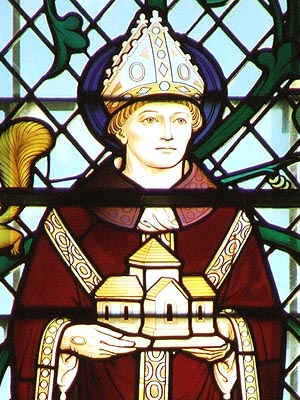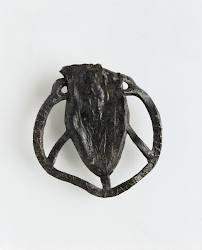St Wulfstan of Worcester
The 19th of January is the feast day of St Wulfstan (also known as Wulstan or Wolstan) an 11th century Anglo-Saxon saint associated with Worcester. This post sets out to explore the saint’s connections with Ireland.

St Wulfstan (Image taken http://www.dioceseofshrewsbury.org/weekly_digests/st-wulfstan-19th-january)
Wulfstan was born in the year 1008 at Long Itchington, Warwickshire. As a young man he entered the priory of Worcester as a novice, he went on to become the cathedral prior before becoming the Bishop of Worcester in 1062. He had a reputation as a pious man.
He devoted his whole life to the care of his diocese, visiting, preaching, and confirming without intermission, rebuilding his cathedral in the simple Saxon style, planting new churches everywhere, and retaining the ascetic personal habits which he had acquired in the cloister. His life, notwithstanding his assiduous labours, was one of continuous prayer and recollection; the Psalms were always on his lips, and he recited the Divine Office aloud with his attendants as he rode through the country in discharge of his episcopal duties ( 1912).
Wulfstan was also a vegetarian. It was said that once while preaching he became distracted by the smell of cooking meat and from that day forth abstained from eating meat. He was an outspoken opponent of the slave trade between Ireland and Bristol and played a large part in the ending of the practice between the two countries.
Following the Norman Conquest of England, Wulstan submitted to King William I and was permitted to retain his position as bishop. By 1075 he was the only Saxon prelate left in England. Wulfstan died at the age of 87 in the year 1095 during his daily service of washing the feet of twelve of the poor of Worcester and he was buried at the cathedral. A rash of miracles were recorded at Wulfstan’s tomb in the year following his death. His cult seems to have remained local until the early 1200’s.
![Worcester Cathedral. ( By Merlincooper at en.wikipedia Later versions were uploaded by Newton2 at en.wikipedia. [CC-BY-SA-2.5 (http://creativecommons.org/licenses/by-sa/2.5) or CC-BY-SA-2.5 (http://creativecommons.org/licenses/by-sa/2.5)], from Wikimedia Commons](https://pilgrimagemedievalireland.com/wp-content/uploads/2014/01/images.jpg?w=640)
Worcester Cathedral by Merlin Cooper (http://commons.wikimedia.org/wiki/File%3AWorcester_cathedral.jpg)
By 1218 the earnings from offerings of pilgrims to Worcester was sufficient to have contributed to the rebuilding of the church and a new shrine for the saint (Spencer 1988, 40). King John (1166-1216) who had a great devotion to Wulfstan was one of the most high status pilgrims to visit Worcester. Such was his devotion to the saint he went on pilgrimage several times and requested to be buried in front of the high altar between St Oswald and St Wulfstan.
So what are St Wulfstan’s connections with Ireland?
The cult of Wulfstan would have arrived in Ireland through the long-established the trade links with Bristol and Dublin and through settlers from Bristol (Spencer 1988, 38). Bristol was located at the edge of the diocese of Worcester the heartland of Wulfstan’s cult.
John Comyn archbishop of Dublin, was on the panel religious appointed by the Pope Innocent III to verify the authenticity of miracles attributed to the saint prior to canonisation (Darlington 1928, 141-3). Given his testament to Wulfstan’s sanctity perhaps he also had a role in promoting the saints cult in Dublin.
Devotion to the saint is represented by the dedication of the Abbey of St Wolstan’s (a variant of Wulfstan), established near Celbridge Co. Kildare by Adam de Hereford, as a monastery in the Order of St Victor circa 1202. This was around the time Wulfstan was canonised by Pope Innocent III (Kildare Historical Website). According to Cane (1918, 55) this abbey was also known as ” Scala Coeli” or ” the Ladder of Heavan” and it grew to become one of the largest monasteries in Ireland with extensive lands in Kildare and Dublin, its buildings covering an estimated 20 acres. It was the first Irish monastery to be dissolved on the orders of Henry VIII. No physical trace of the monastery remains today but Crane states in the early 1900’s
The remains of the priory buildings consist of two large archaways which I imagine formed the north and south gates of the main enclosure, 200 yards apart, a tall square tower or keep 50 yards further.
We know of two Irish people went on pilgrimage to Worcester. The first pilgrim was mentioned in the Vita Wulfstani/Life of Wulfstan. The Vita records a miracle bestowed on an Irish pilgrim to Worcester.
This miracle refers to the healing of an Irishman named Pippard, whose tongue had been cut out by Hugh de Laci, Earl of Ulster from 1205 until his expulsion from Ireland in 1210. The Annals of Worcester record that Pippard built a church in Ireland in honour of St Wulfstan and gave it to the church of Worcester together, with 30 carucates of land (a carucate being the amount of land that could be tilled by a team of eight oxen in a ploughing season) (Roswell 2012; Darlington 1928, 141).
This passage implies Irish pilgrims were visiting St Wulfstan’s shrine in the late 12th/early 13th century prior to and following the canonisation although it is difficult to quantify in what numbers. To reach the shrine pilgrims would have travelled by ship to Bristol and then on to Worcester.
Evidence of a second Irish pilgrimage and devotion to the saint was discovered during excavations of medieval Dublin, when a pilgrim ampulla (tiny flask) from the shrine at Worcester, was found at High Street. The ampulla is now on display at the National Museum of Ireland at Kildare street.

Pilgrim ampulla found in excavations at High Street, Dublin in the late 1960s. The object is thought to date c.1225–50. © The National Museum of Ireland (Image http://vidimus.org/issues/issue-58/feature/)
The flask is decorated on two sides, on one side there is an image of St Wulfstan dressed as bishop, the Virgin Mary appears on the other side. Worcester cathedral was dedicated to St Mary and from the 12th century it was in possession of a statue of St Mary which attracted great devotion and pilgrims. By the 15th century devotion to this statue suppressed that of Wulfstan and Oswald.
From the 12th century many pilgrim shrines sold specially designed souvenirs such as badges and ampullae, that depicted imagery specific to the shrine to pilgrims. Ampullae were especially popular in England. The Dublin ampulla which dates to the 13th century was purchased by an Irish pilgrim at Worcester and would have contained holy water obtained at the shrine (Spenser 1988, 40). The Dublin find is very unique as it is the only known pilgrim souvenir from Worcester to have survived.
It’s very likely that these two pilgrims represent only a fraction of Irish pilgrims to who travelled Worcester.
References
Darlington, R. 1928. (ed.), The Vita Wulfstani of William of Malmesbury, London: Royal Historical Society.
Flower, R. 1940. ‘A Metrical Life of St Wulfstan of Worcester’, National Library of Wales Journal, i/3, 119-130.
1912. St. Wolstan. In The Catholic Encyclopaedia. New York: Robert Appleton Company. Retrieved January 14, 2014 from New Advent: http://www.newadvent.org/cathen/15687a.htm
Kildare Local History. ‘History of Celbridge’, http://kildarelocalhistory.ie/celbridge/history-of-celbridge/churches-monasteries/
Roswell, R. 2012. ‘Medieval Painted and Stain Glass at Worcester Cathedral Priory, Part II: The Priory Cloisters’ Vidimus Journal Vol. 58, http://vidimus.org/issues/issue-58/feature/
Spencer, B 1988. ‘Pilgrim Souvenirs’, In Wallace, P (ed.) Miscellanea 1. MedievalDublin Excavations 1962-81(Series B) Vol.2 Fascicules 1-5. Dublin: Royal Irish Academy, 33-48.